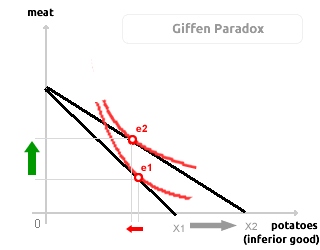Giffen Paradox
The Giffen Paradox presents a fascinating exception to the law of demand. According to this law, the quantity demanded of a good is inversely related to its price; it rises when prices fall and vice versa. However, with Giffen goods, the situation is quite the opposite. Demand for a Giffen good is paradoxically positively correlated with its price, resulting in an upward slope on a Cartesian graph. In the diagram below, we place a normal good (meat) on the y-axis and an inferior good (potatoes) on the x-axis. A decrease in the price of the inferior good (potatoes) increases the consumer's maximum purchasing power from X1 potatoes to X2 potatoes. Nevertheless, consumer preferences lead to a reduction in the consumption of the inferior good and an increase in the consumption of the normal good, shifting from equilibrium point e1 to equilibrium point e2. This scenario is paradoxical, as the quantity demanded of the good actually decreases when its price drops.

In the 19th century, Scottish economist Robert Giffen identified a remarkable exception to the law of demand, particularly concerning inferior goods that constitute a significant portion of consumer spending. For these inferior goods, demand tends to rise as income decreases (e.g., staple food items). An increase in the price of inferior goods leads to a substantial decline in consumers' real income since these goods represent a considerable share of their expenditures. This reduction in real income subsequently drives up the demand for inferior goods, including the very good whose price has risen. Giffen observed this relationship in the case of Irish potatoes.
Note. Giffen studied this phenomenon in 19th-century Ireland by analyzing market demand for potatoes following a price increase. The rise in potato prices significantly diminished the real income of the Irish, as potatoes were a crucial component of their diet. However, since potatoes are also regarded as an inferior good and a low-cost food relative to others (e.g., meat, flour), the decline in real income led to a paradoxical increase in their consumption of affordable potatoes at the expense of meat and flour. Conversely, a decrease in potato prices boosts consumers' real income, enabling them to increase their consumption of more sophisticated food items (normal goods) while reducing their intake of basic food items (inferior goods).
